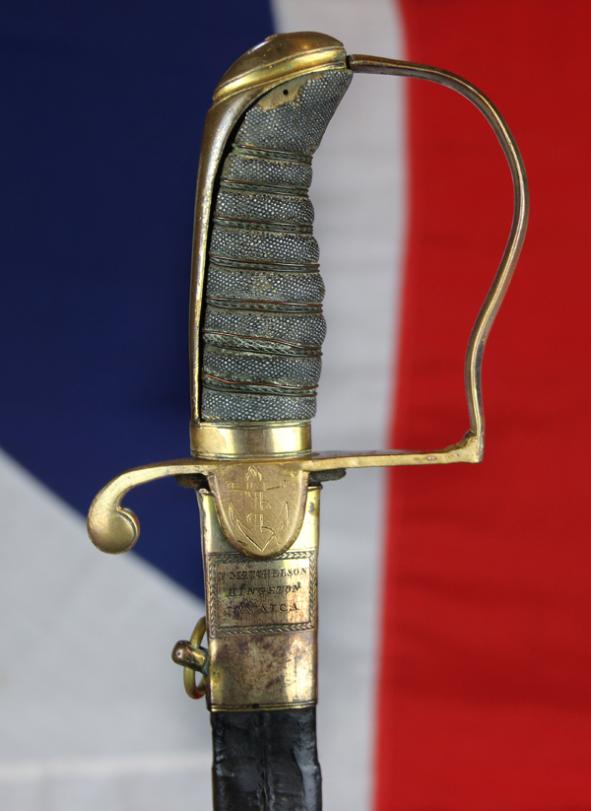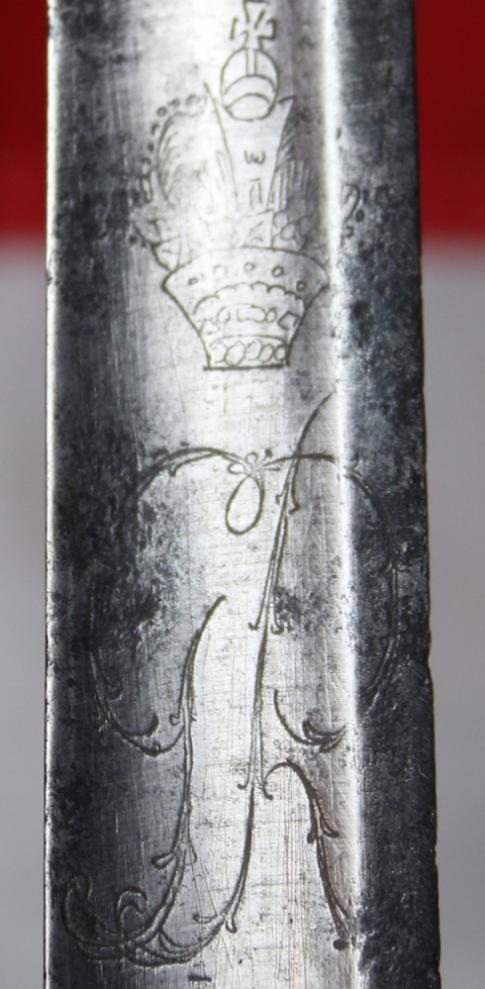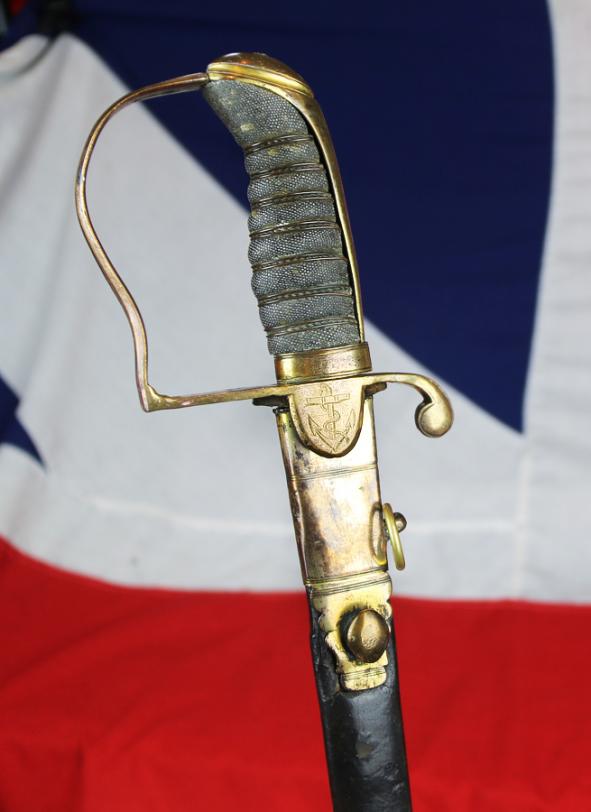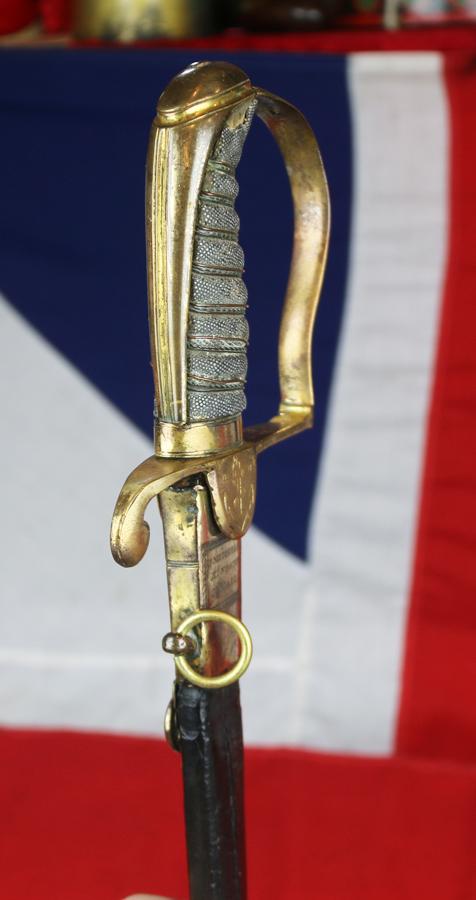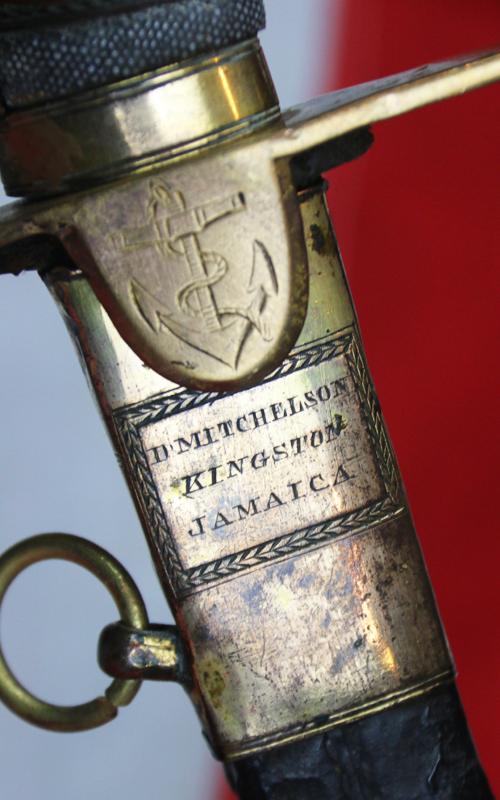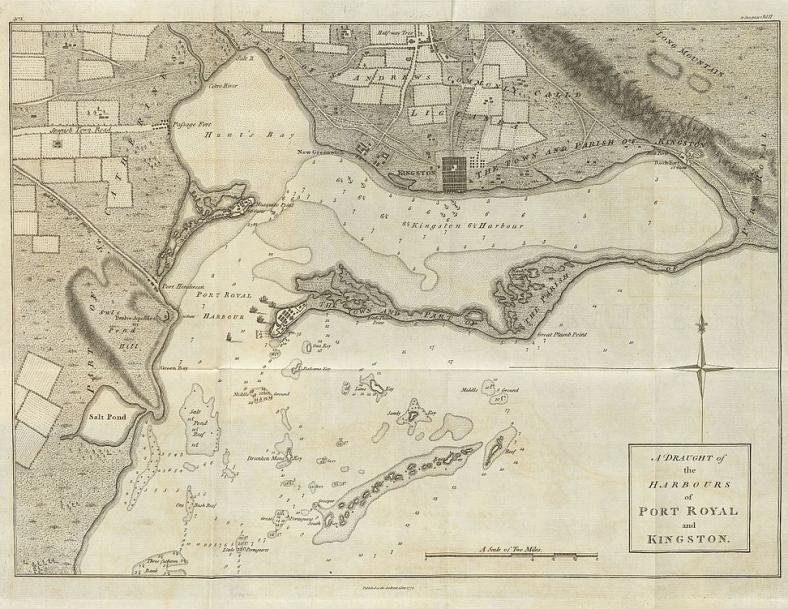A Superb & Rare, Napoleonic Wars Period ‘Port Royal’, Jamaica, Caribbean Station Service, British Royal Naval Officer's Sword 1805. Admiral Horatio Nelson Period. By Mitchellson of Kingston Jamaica
Particularly rare Nelson period Royal Naval junior officer's sword as it was commissioned for its officer in Jamaica, for an officer that served from Port Royal, the Caribbean Royal Naval port, in Jamaica, the centre of the Royal Navy in the Caribbean from 1655. The Jamaica Station of the United Kingdom's Royal Navy was based in Port Royal, Jamaica from 1655 to 1830. In 1800, Vice-Admiral Lord Hugh Seymour was the commander in chief of the Jamaica Station.
Jamaican made Royal Naval swords from the era of Nelson are as rare as hen's teeth, and one may not see another available for many decades, if at all.
For a collector of all things Nelsonian, based around Nelson's navy era, this is an absolute must, it would superbly compliment a collection of midshipman's dirks, regular domestic British made 1805 pattern swords, either the type made for officers up to the rank of senior lieutenant, or the type made for commanders and above or admirals.
Port Royal has an incredible maritime history, possibly the most famous of the maritime world, and at the very heart of the notorious piracy conducted in the Caribbean, Port Royal provided a safe harbour initially for privateers and subsequently for pirates plying the shipping lanes to and from Spain and Panama. Buccaneers found Port Royal appealing for several reasons. Its proximity to trade routes allowed them easy access to prey, but the most important advantage was the port's proximity to several of the only safe passages or straits giving access to the Spanish Main from the Atlantic. The harbour was large enough to accommodate their ships and provided a place to careen and repair these vessels. It was also ideally situated for launching raids on Spanish settlements. From Port Royal, Christopher Myngs sacked Campeche and Henry Morgan attacked Panama, Portobello, and Maracaibo. Additionally, buccaneers Roche Brasiliano, John Davis and Edward Mansvelt used Port Royal as a base of operations.
Since the English lacked sufficient troops to prevent either the Spanish or French from seizing it, the Jamaican governors eventually turned to the pirates to defend the city. By the 1660s the city had, for some, become a pirate utopia and had gained a reputation as the "Sodom of the New World", where most residents were pirates, cutthroats, or prostitutes. When Charles Leslie wrote his history of Jamaica, he included a description of the pirates of Port Royal:
Wine and women drained their wealth to such a degree that ... some of them became reduced to beggary. They have been known to spend 2 or 3,000 pieces of eight in one night; and one gave a strumpet 500 to see her naked. They used to buy a pipe of wine, place it in the street, and oblige everyone that passed to drink.
The taverns of Port Royal were known for their excessive consumption of alcohol such that records even exist of the wild animals of the area partaking in the debauchery. During a passing visit, famous Dutch explorer Jan van Riebeeck is said to have described the scenes:
The parrots of Port Royal gather to drink from the large stocks of ale with just as much alacrity as the drunks that frequent the taverns that serve it.
There is even speculation in pirate folklore that the infamous Blackbeard (Edward Teach) met a howler monkey, while at leisure in a Port Royal alehouse, whom he named Jefferson and formed a strong bond with during the expedition to the island of New Providence. Recent genealogical research indicates that Blackbeard and his family moved to Jamaica where Edward Thatch, Jr. is listed as being a mariner in the Royal Navy aboard HMS Windsor in 1706. Port Royal benefited from this lively, glamorous infamy and grew to be one of the two largest towns and the most economically important port in the English colonies. At the height of its popularity, the city had one drinking house for every 10 residents. In July 1661 alone, 40 new licenses were granted to taverns. During a 20-year period that ended in 1692, nearly 6,500 people lived in Port Royal. In addition to prostitutes and buccaneers, there were four goldsmiths, 44 tavern keepers, and a variety of artisans and merchants who lived in 2,000 buildings crammed into 51 acres (21 ha) of real estate. 213 ships visited the seaport in 1688. The city's wealth was so great that coins were preferred for payment over the more common system of bartering goods for services.
Following Henry Morgan's appointment as lieutenant governor, Port Royal began to change. Pirates were no longer needed to defend the city. The selling of slaves took on greater importance. Upstanding citizens disliked the reputation the city had acquired. In 1687, Jamaica passed anti-piracy laws. Consequently, instead of being a safe haven for pirates, Port Royal became noted as their place of execution. Gallows Point welcomed many to their death, including Charles Vane and Calico Jack, who were hanged in 1720. About five months later, the famous woman pirate Mary Read died in the Jamaican prison in Port Royal. Two years later, 41 pirates met their death in one month. From 1735, Port Royal once more became the focus of the Admiralty's attention. New wharves and storehouses were built at this time, as well as housing for the officers of the Yard. Over the next thirty years, more facilities were added: cooperages, workshops, sawpits, and accommodation (including a canteen) for the crews of ships being careened there. A Royal Naval Hospital was also established on land a little to the west of the Naval Yard; and by the end of the 18th century a small Victualling Yard had been added to the east (prior to this ships had had to go to Kingston and other settlements to take on supplies)
Every item is accompanied with our unique, Certificate of Authenticity. Of course any certificate of authenticity, given by even the best specialist dealers, in any field, all around the world, is simply a piece of paper,…however, ours is backed up with the fact we are the largest dealers of our kind in the world, with over 100 years and four generation’s of professional trading experience behind us
Code: 23397


